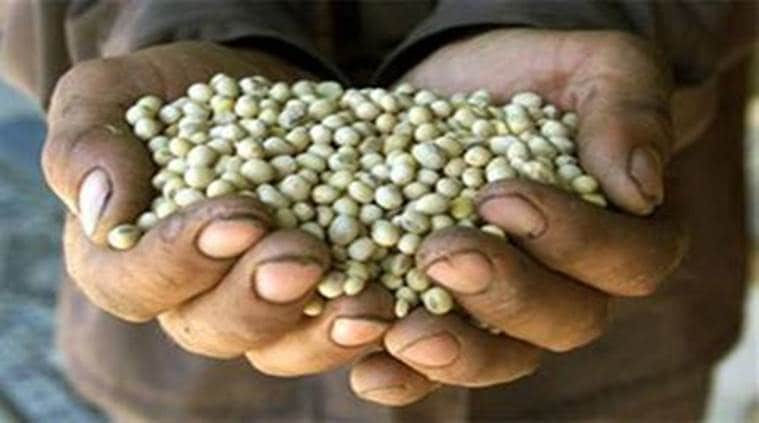 Trade war opens a window of opportunity for soyabean growers in poll-bound Madhya Pradesh and Rajasthan.
Trade war opens a window of opportunity for soyabean growers in poll-bound Madhya Pradesh and Rajasthan.
In times of farm distress, a little bit of luck can make a big difference. For soyabean growers, particularly in Madhya Pradesh and Rajasthan, which go to polls later this year, that luck could come from the trade tensions between the US and China.
China is the world’s largest importer of soyabean. In 2016-17 (October-September), it bought 93.49 million tonnes (mt) of this oilseed — the major suppliers being the US (36.84 mt), Brazil (45.34 mt) and Argentina (6.67 mt).
But with China clamping a 25 per cent duty on US soyabean with effect from July 6 — as part of retaliatory measures against the President Donald Trump’s tariffs on some $34 billion worth of Chinese goods — a new opportunity has opened up for India. It comes even as the Centre has hiked the minimum support price (MSP) for this year’s soyabean crop to Rs 3,399 per quintal, from Rs 3,050 for 2017-18.
India exported oilseeds — in the form of de-oiled cake or meal — to China last in 2010-11. That year, it shipped out around 0.4 mt of rapeseed meal and another 0.3 mt of soyabean meal. But from January 2012, China suspended all imports, when some Indian rapeseed meal consignments were allegedly found contaminated with malachite green, a chemical dye. The source of it was supposedly the ink used to mark jute bags carrying the produce.
From this July, however, China removed all tariffs on soyabean and meal — earlier at 3 per cent and 5 per cent — imported from five APTA (Asia-Pacific Trade Agreement) countries: India, Bangladesh, Sri Lanka, South Korea and Laos. All of them, barring India, are insignificant suppliers.
EXPLAINED | How a US-China trade war can hit Indian market
“They seem inclined to resume purchases from us. What remains to be seen is whether they will also ease non-tariff barriers relating to quarantine restrictions. We have requested the Commerce Ministry to seek clarifications on the phytosanitary certificates required by AQSIQ (General Administration of Quality Supervision, Inspection and Quarantine of the People’s Republic of China) against about 12 pests and diseases. That should hopefully not be an issue since we only export processed meal and not grain,” said B V Mehta, executive director, Solvent Extractors’ Association of India.
The US may well respond to the Chinese import curbs by selling more soyabean to Brazil and Argentina, which are also big consumers (meal is an ingredient for animal feeds). These countries may, in turn, export a large share of their produce to China. But even after factoring in these possibilities, “they (Chinese) will still have to explore alternative supply sources”, said Mehta.
Davish Jain, chairman of the Indore-based Soyabean Processors Association of India (SOPA), estimated that India can “potentially export 2 mt of soyabean meal and another 1-2 mt of rapeseed meal to China”.
This should be good news for farmers in MP, Maharashtra and Rajasthan, which account for 58.45 million hectares (mh), 35.84 mh and 10.80 mh out of the country’s normal (five-year average) area of 112.51 mh sown under soyabean. Oilseed is now trading in Indore’s Gautampura market at Rs 3,500 per quintal, which is above the Rs 2,850 levels a year ago and also the current MSP of Rs 3,399.
Last year, soyabean prices ruled Rs 400-500 per quintal below the MSP of Rs 3,050 through much of the main marketing season from October to December. It resulted in the MP government unveiling the Bhavantar Bhugtan Yojana scheme, under which farmers were paid the difference between the MSP and the average “modal” or most-quoted rate in mandis for the quantities sold by them.
The scheme faced flak as traders reportedly used it to further depress prices at which farmers sold and made a killing later on when the crop turned out to be lower than expected. SOPA had, at the start of the marketing season in October, pegged the 2017-18 soyabean crop at 9.15 mt – which it revised downwards, in February, to 8.35 mt.
Things could be different this time. While the carry-over stocks in October 2017 were assessed at 1.3 mt, the coming season will open with hardly 0.1 mt. The resultant tight position – plus the China demand factor – should help keep prices well above MSP, when the next crop arrives in the mandis. And that would be around the time of the Assembly elections, in which the votes of soyabean farmers will certainly count.